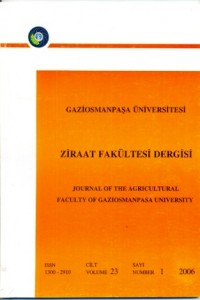Abstract
The aim of this study is to examine important physical and mechanical properties of particle boards which were produced by adding plastic waste grinded to a certain particle size into wood shavings and using urea formaldehyde glue. The following values were obtained from the samples which were prepared to have different mixture proportions: unit weight was 684-966 kg/m3, thickness increment after a 24 hour water exposure was 1% -12%, the amount of water absorption was 21% -85%, bending strength was 5.20-17.94 MPa, perpendicular tensile strength was 0.15-1.32 MPa and heat conduction 0.128-0.160 W/mK. According to the results of the study, it was concluded that most of the characteristics of particle boards which are suggested under the related standards could be improved by reusing plastic waste for the production of particle boards, and that, in addition to this, negative environmental consequences caused by wastes could be minimized by utilizing plastic waste in this way.
References
- Anonymous, 1998. Wood fibreboards-Definition, classification and symbols TS 3635 EN 316, Turkish Standards Institution, Ankara.
- Anonymous, 1999a. Particleboards- SpecificationsPart 2: Requirements for general purpose boards for use in dry condıtıonsTS-EN 312-2, Turkish Standards Institution, Ankara.
- Anonymous, 1999b. Particleboards- SpecificationsPart 3: Requirements for boards for interior fitments (including furniture) for use in dry conditions-TS-EN 312-3, Turkish Standards Institution, Ankara.
- Anonymous, 1999c. Wood- Based panels- Sampling, cutting and inspection- Part 1: Sampling test pieces and expression of test results, TS-EN 326-1, Turkish Standards Institution, Ankara.
- Anonymous, 1999d. Particleboards and fibreboardsDetermination of tensile strength perpendicular to the plane of the board TS-EN 319, Turkish Standards Institution, Ankara.
- Anonymous, 1999e. Particleboards- Specifications- Part 6: Requirements for heavy duty load-Bearing boards for use in dry conditions TS-EN 312-6, Turkish Standards Institution, Ankara.
- Eroğlu,.H., 1994. Lif levha endüstrisi. Karadeniz Teknik Üniversitesi Orman Fakültesi Yayını, No:45, Trabzon.
- Espenschied, R.F., 1995. Playwood applications in farm construction. Vocational Agriculture Service, College of Agriculture, Illions.
- Kollman, F.P., Kuenzi, E.W.and Stamm, A.J.,1975. Principles of wood science and technology II.Wood Based Materials, springer ferlag, Berlin.
- McColly, H.F. and Martin, J.W., 1995. Introduction to agricultural engineering. McGraw-Hill Book Company, Inc.
- Muszynski, Z. and McNatt, J.D, 1984. Investigations on the use of spruce bark in the manufacture of particle board in Poland. Forest products research society, Forest product journal, 34 (1) :28-35
- Örüng, İ. ve Şahin, S., 1998. Bitkisel artıkların tarımsal yapılarda yapı malzemesi olarak değerlendirilmesi olanakları üzerine bir araştırma. Doğu Anadolu Tarım Kongresi (14-18 Eylül,1998), Erzurum.
Abstract
Bu çalışmanın amacı, odun yongasına belirli büyüklüğe kadar öğütülmüş atık plastik ilavesiyle üre formaldehit tutkalı kullanılarak üretilen yonga levhaların önemli fiziksel ve mekanik özelliklerini incelemektir. Farklı karışım oranlarına sahip olmak üzere hazırlanan örneklerin, birim ağırlık değeri 684-966 kg/m3, 24 saat suda bekletme sonucu kalınlık artışı % 1-12, su emme miktarı % 21-85, eğilme direnci 5.20-17.94 MPa , yüzeye dik çekme direnci 0.15-1.32 kgf/cm2 ve ısı iletim katsayısı 0.28-0.160 W/mK olarak elde edilmiştir. Araştırma sonuçları; yonga levha üretiminde plastik atığın kullanımı ile yonga levhanın ilgili standartta öngörülen bir çok özelliğinin iyileştirilebileceği ve bunun yanında atık plastiklerin bu şekilde değerlendirilmesiyle olumsuz çevresel etkisinin azaltılabileceği kanısına varılmıştır.
References
- Anonymous, 1998. Wood fibreboards-Definition, classification and symbols TS 3635 EN 316, Turkish Standards Institution, Ankara.
- Anonymous, 1999a. Particleboards- SpecificationsPart 2: Requirements for general purpose boards for use in dry condıtıonsTS-EN 312-2, Turkish Standards Institution, Ankara.
- Anonymous, 1999b. Particleboards- SpecificationsPart 3: Requirements for boards for interior fitments (including furniture) for use in dry conditions-TS-EN 312-3, Turkish Standards Institution, Ankara.
- Anonymous, 1999c. Wood- Based panels- Sampling, cutting and inspection- Part 1: Sampling test pieces and expression of test results, TS-EN 326-1, Turkish Standards Institution, Ankara.
- Anonymous, 1999d. Particleboards and fibreboardsDetermination of tensile strength perpendicular to the plane of the board TS-EN 319, Turkish Standards Institution, Ankara.
- Anonymous, 1999e. Particleboards- Specifications- Part 6: Requirements for heavy duty load-Bearing boards for use in dry conditions TS-EN 312-6, Turkish Standards Institution, Ankara.
- Eroğlu,.H., 1994. Lif levha endüstrisi. Karadeniz Teknik Üniversitesi Orman Fakültesi Yayını, No:45, Trabzon.
- Espenschied, R.F., 1995. Playwood applications in farm construction. Vocational Agriculture Service, College of Agriculture, Illions.
- Kollman, F.P., Kuenzi, E.W.and Stamm, A.J.,1975. Principles of wood science and technology II.Wood Based Materials, springer ferlag, Berlin.
- McColly, H.F. and Martin, J.W., 1995. Introduction to agricultural engineering. McGraw-Hill Book Company, Inc.
- Muszynski, Z. and McNatt, J.D, 1984. Investigations on the use of spruce bark in the manufacture of particle board in Poland. Forest products research society, Forest product journal, 34 (1) :28-35
- Örüng, İ. ve Şahin, S., 1998. Bitkisel artıkların tarımsal yapılarda yapı malzemesi olarak değerlendirilmesi olanakları üzerine bir araştırma. Doğu Anadolu Tarım Kongresi (14-18 Eylül,1998), Erzurum.
Details
| Primary Language | Turkish |
|---|---|
| Journal Section | Research Articles |
| Authors | |
| Publication Date | June 1, 2006 |
| Published in Issue | Year 2006 Volume: 2006 Issue: 1 |


